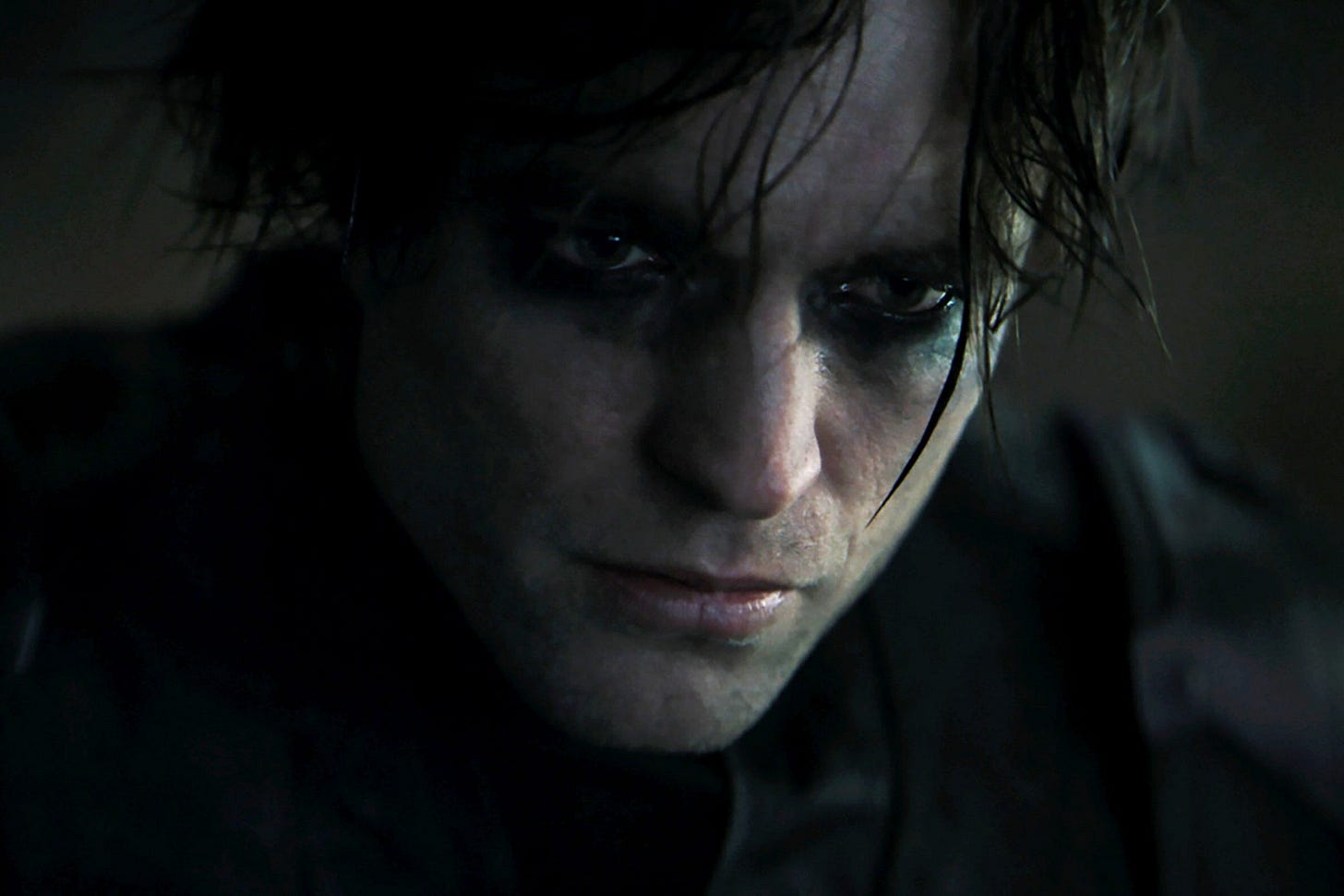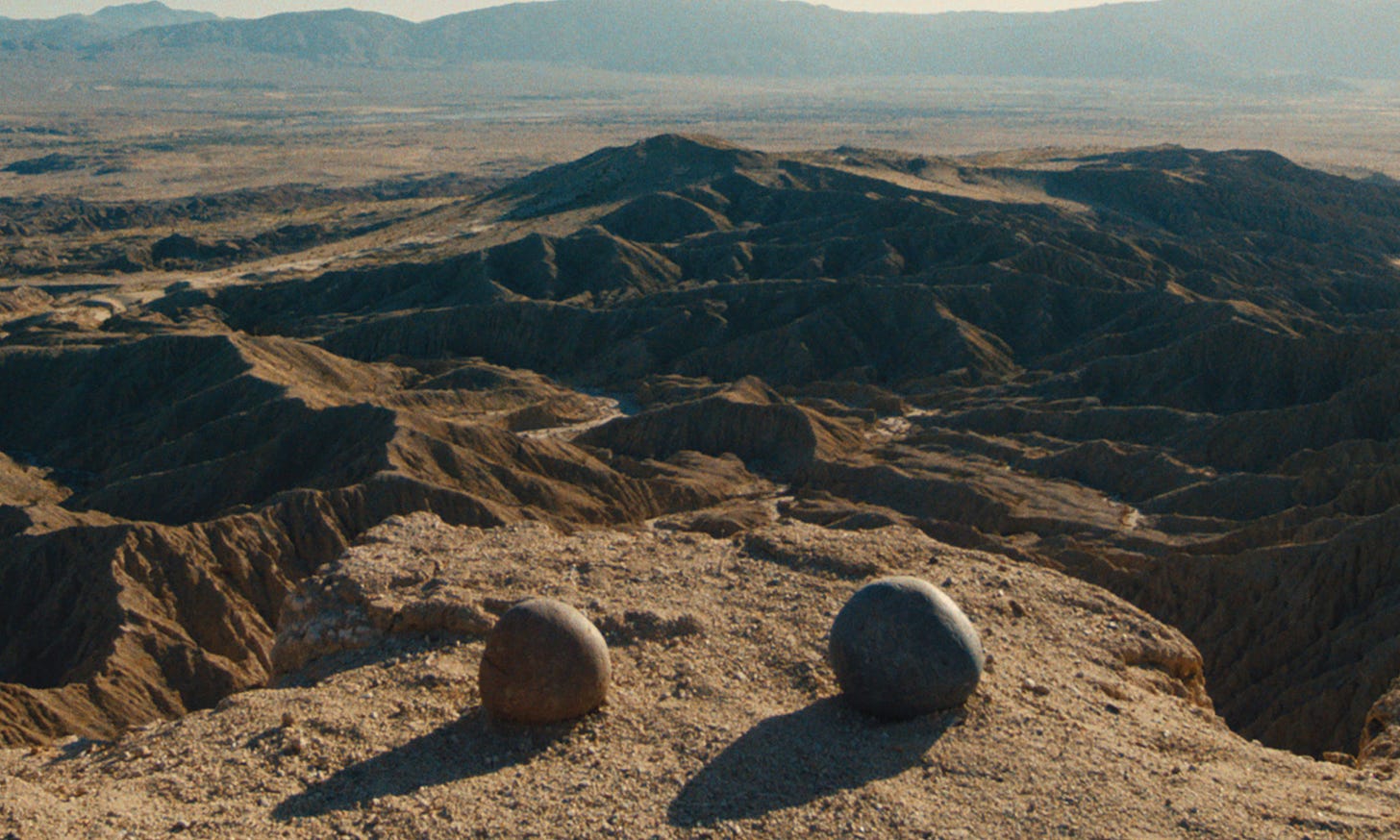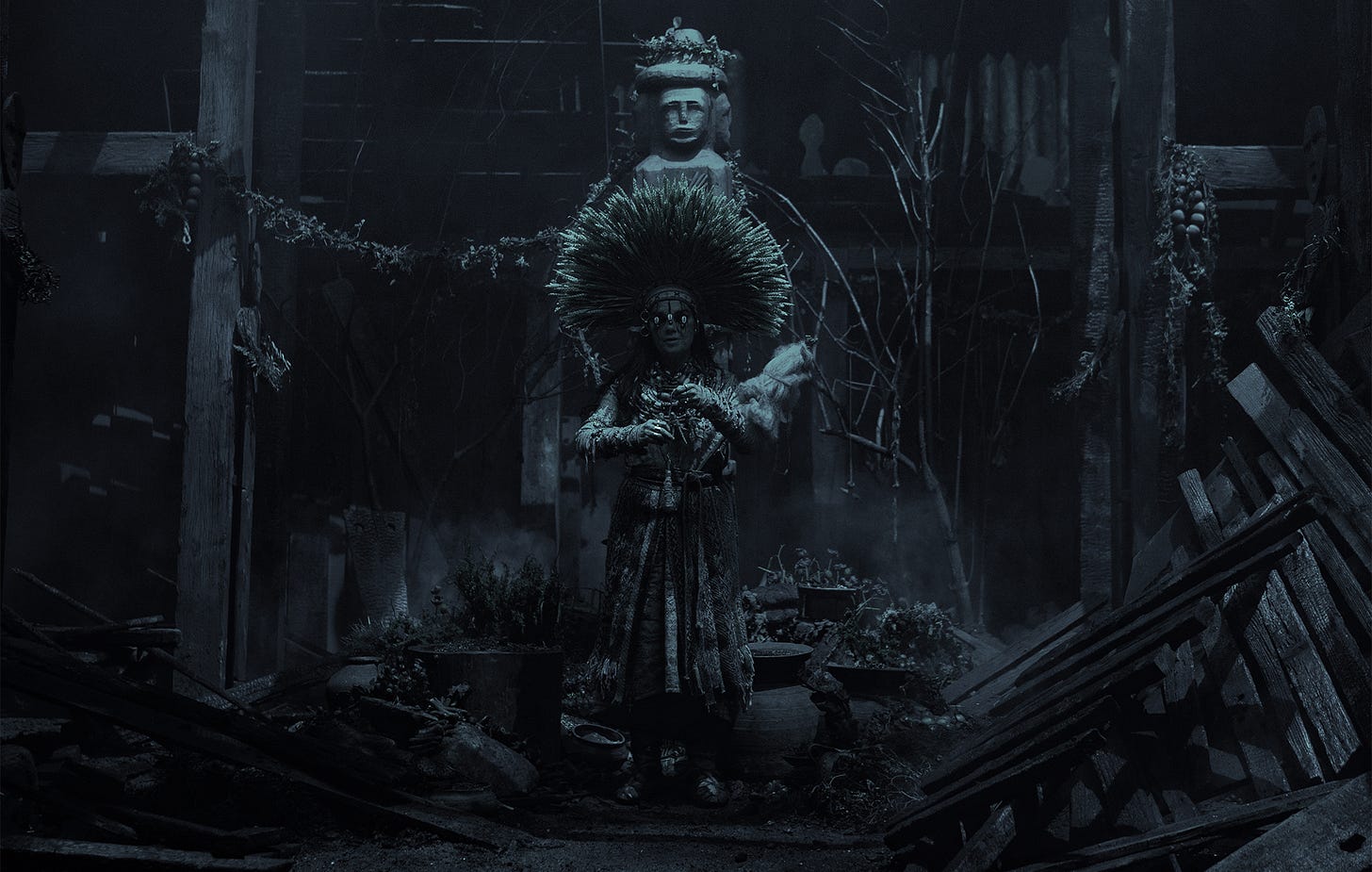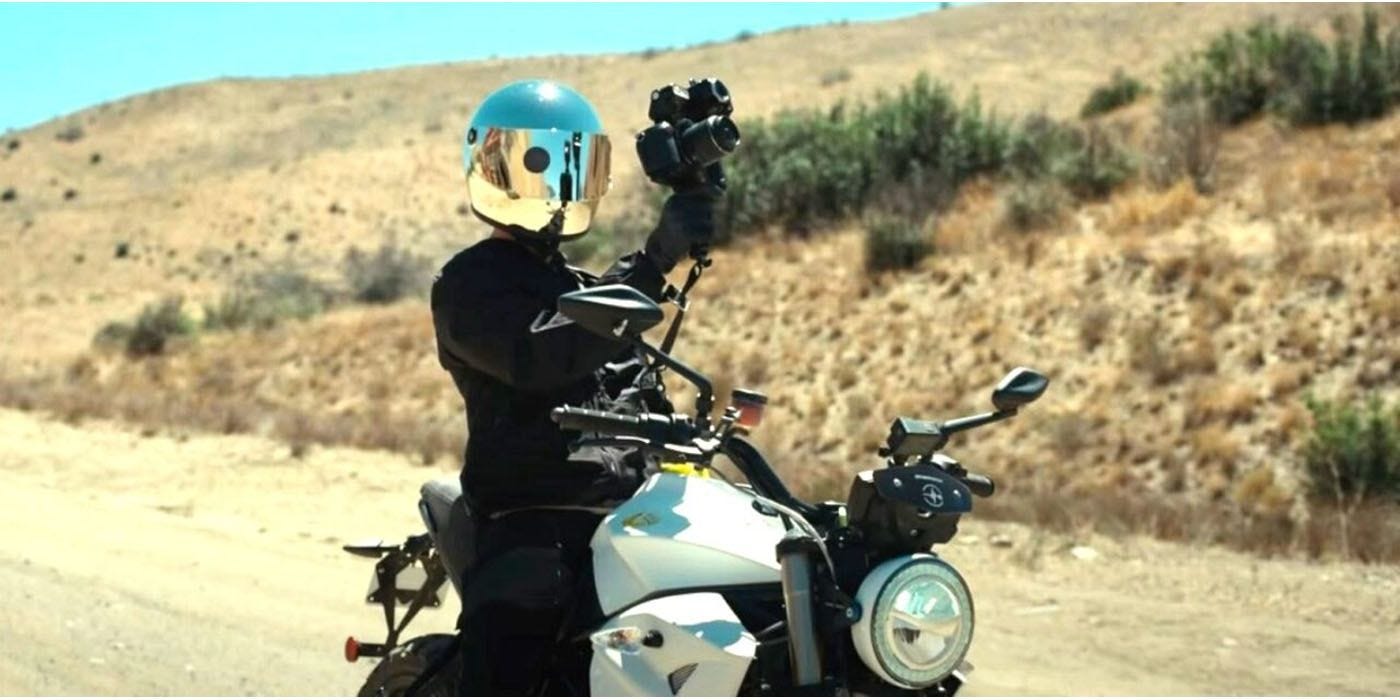Last year when I wrote about returning to movie theaters in a freshly unlocked New York City, I argued that the competition between new and old movies has never been fiercer. In 2022, in the battle for my attention on the big screen, both sides lost. I did not see many movies in 2022. Old movies faired worse. Didn’t see a single one in person. But new movies put up such poor numbers that I can hardly declare them a winner.
I can think of a few explanations for the drop off. First, going to the movies is a feedback loop. Movie theaters are their own most effective advertisers. Trailers are better on a big screen. Get in the rhythm of going and theaters start organizing your calendar for you. So why didn’t I get in the rhythm? Easy to blame the year’s new releases, though there are a handful that I’m genuinely bummed that I missed and a few I’m going to make an effort to catch after I publish this letter. I think the biggest culprit is the absence of a job with a concrete schedule. A shift and a commute gives you something to organize around. The amorphous patchwork of creative & gig work I’ve quilted for myself has less rigid edges, and when I do feel like calling it quits the small, good, screen is ready to go.
So I only made it out to the movies seven times this year. Here’s what I saw, and who I saw it with. Assume there will be spoilers:
The Batman
Where: An AMC in a mall outside of Boston, MA
With: Oliver, Christian
Bellows played a quick four show tour on the Northeast in March. Boston was night two. Since we spent night one just over the border from Rhode Island, we had a lot of time to kill before our set. Frank and Jack set up shop in a Panera Bread. Oliver and I went to the other side of the mall to see The Batman, along with Oliver’s friend Christian. I’d hung out with Christian a few times and I think we’ve gotten along fine, but I wouldn’t say that I know them particularly well. I bring this up because I spent the first 90 minutes or so of The Batman unsure whether I was alone in how I felt about what we were watching. Under such conditions it was hard to tell how openly I should express that feeling. No one wants to create an awkward mood in a three and half hour long movie. But when the Batmobile roared through a pillar of flames over a bunch of crashed trucks, I could contain myself no more. Christian and I whispered over the sound of fire, screaming cars, and triple forte cellos:
“This fucking rules”
“Dude, I know”
Woe be the leftist that mounts a defense of the dark knight. The last two decades of modernized Bruce Waynes make it impossible to ignore the reactionary pulse at the heart of the character. My favorite versions of the character are ones that place him firmly in an imagined past. Not only does a period setting preserve Batman’s pulpy origins, it also keeps me from thinking about who Batman’s real life billionaire counterparts would beat up if they could get away with it.
The Batman isn’t a period piece, but it’s the first Batman in a long time to treat the present day with the heightened tone of one. Sure, the villain is a murderous live-streamer and Gotham is a clear stand in for post-Hurricane Sandy New York. It is inescapably a story set in the present. But it renders our present with such overblown gothic darkness as to make it unrecognizable. Nonstop rain, blood red sunsets, overbearing religious music, Robert Pattinson’s impossible gauntness… Batman finally feels like a cartoon again.
This aesthetic course correction has a mirror in the The Batman’s story. Pattinson’s Wayne begins in a state of self-doubt, questioning whether his presence in Gotham has only stoked more crime & violence. The disconnect between Wayne’s aims and his actual effect only gets wider the deeper he digs into the mystery, until in the film’s climax he comes face to face with his real legacy: a troop of reactionary goons in paramilitary cosplay justifying terror as revenge. Horrified by the realization, Wayne walks away from the fight to rescue an orphaned boy, who he leads out of darkness into what amounts to The Batman’s version of light.
Has Pattinson rescued Batman’s inner child? All I can say is that this movie reminded me more of a lazy weekend watching a Batman: The Animated Series marathon than any other adaptation.
The show went great. We played with Lake Saint Daniel and Ladypills. Sold out crowd. Stayed the night in Boston with friends. I was so exhausted that I passed out with the lights on.
Everything Everywhere All At Once
Where: An AMC in Durham, NC
With: Oliver, Jack
Bellows went on another tour in April, this time heading south. It did not go as planned. After two shows, first in Philly then in Brooklyn, three of us woke up with COVID. We cancelled all but the last two shows of the tour, hunkered down for a week, and then jumped back in the car and hightailed it to North Carolina.
No matter how often I tour, I still spend my first morning away from home in a soft daze of disorientation. “Where am I again? what is my life like now?” that kind of stuff. Waking up in a stranger’s bed in a different state after the monotony of quarantine cranked that feeling until the handle broke. Which is all to say that when Oliver, Jack, and I decided to watch Everything, Everywhere, All At Once before our show that night in Durham, I was in about as ideal a condition as I can imagine to receive the movie.
For a good hour and a half EEAAO1 had me right where it wanted me. Like it’s main character Evelyn, I too felt like I was trapped in the worst-possible version of the world, dead-ended by my own choices and the indiscriminate whims of powers beyond my control. I too felt like I was hurtling between dimensions without a solid grip on reality. And, I was just delirious enough from the whiplash of driving 500 miles in a day, fresh off a society busting plague, to laugh at every joke Scheinert & Kwan threw at me.
And then they just… kept throwing jokes at me.
Everything Everywhere’s bone-deep commitment to its bits is its greatest strength and its undoing. Nearly every throw-away gag gets picked back up and redeployed for dramatic pathos. All of these first-as-comedy-then-as-melodrama beats explode into fireworks, and, I’ll admit, some waterworks on my part, in the movie’s final 25 minutes. Managing this symphony of payoffs is an athletic feat on the part of the cast and crew. I respect and appreciate the creative generosity of going for it as hard as The Daniels do here. But that generosity started to feel more like “showing your work” the longer it dragged on. The cost of this commitment is that the characters feel less and less like people over time. The specificities of their lives recede vague platitudes surge to the front.
Look, I’m glad everyone had a real good time with this one. It’s cool that a movie so aggressively itself found an audience. And boy am I glad to see an American movie with martial arts that aren’t just grey-scale krav maga. The movie worked on me, I laughed and cried when I was supposed to, but by the time I’d crossed the parking lot I was already concocting preferable alternatives. Why not go all the way in on the intergenerational theme and give the grandfather more of an internal life?
I don’t remember much of the show that night. It felt weird to be back on stage again, but I’m glad that we didn’t let COVID wipe out the whole tour.
The Northman
Where: The Nitehawk in Brooklyn, NY
With: Ashna
“Oh, that looks like my shit” I told my roommate Ashna during an ad for The Northman while watching sports. This observation, bold enough that we made plans to see The Northman in theaters on its merits, is true in a strictly literal sense. The Northman looks like a movie that I’d enjoy. Grand Iceland settings, dudes fighting with swords at a volcano, Björk whispering ominous prophecy, a lil’ fox guy running around. It all looks great. But The Northman is not my shit.
Ashna and I saw The Northman at The Nitehawk just outside of Prospect Park in Windsor Terrace. The Nitehawk is one of those theaters that plays clips of other movies that share actors or themes with the feature presentation while people find their seats. So before The Northman we sat through a montage of actors swearing vengeance for the death of their fathers. The number of films including only served to provoke the question of how many other Hamlet wannabes were left on the cutting floor.
I could not imagine a harder act for The Northman to follow than a primer on all of its cliches. Eggers gets some milage out of his rigorous eye for detail and the genuine strangeness that he renders the past with, but none of that detail or wonder makes its way into the movie’s plot. Underneath the severe style, all that’s left is a by-the-numbers revenge tale that’d fit right into the 00s swords & sandals boom.
I’ll take stylish and stupid over just plain stupid, but most of The Northman felt like watching someone else play a video game, and not a good one. Also, watching Skarsgård hunched over from his own weight for a whole movie made my neck hurt by proxy. I get that there many dudes out there that feel like they need to pack on as much muscle as is medically possible in order to live up to a distorted dream they have about ancient tough guys, but I promise you dude, you did not have to go that hard.
Men
Where: The Nitehawk in Brooklyn, NY
With: Alone
I knew this was a bad idea, but I was compelled. Alex Garland makes my kind of 7 out of 10 movie. Flawed, ambitious, too heady and too blunt at once, convinced of the profundity of its themes, though usually most transcendent when everyone shuts up and just moves through space in a cool way. The guy made Annihilation, and I love Annihilation. You make something as rad as the lighthouse sequence at the end of that movie and I will buy tickets to see your next one even if it looks like a parody of itself.
I did not love Men, but I am amused that it exists. Men is so hamfisted, so lacking in subtlety in any of its metaphors, that it might be the straw that breaks A24’s horror elevator for good. The snake has final eaten its own tail, or given birth to itself, or whatever stock symbolism you’d prefer we zoom in on all symmetrically while a lone woman sings a minor key.
Alex Garland does not have a single insightful thing to say about men and women, but Men can’t help but say something insightful about Garland. The man is too online. Men reads like a synthesis of Garland’s social media intake, only spat back out before he could finish chewing. The movie does get genuinely creepy and gross by the end, and that was fun, but the real chills and thrills came from watching an artist skid out of control as he races to catch up with the cultural conversation.
Top Gun: Maverick
Where: The Nitehawk in Brooklyn, NY
With: Alone
I bought a ticket to see Top Gun: Maverick at the last minute on a whim on my birthday. Never seen the original, but I mean c’mon, I’m an American citizen that’s seen a movie or two, I get the idea. Besides, both Top Guns belong to the much bigger canon (maybe the only true Hollywood franchise) of Tom Cruise Doing Crazy Shit.
His latest act of reckless bravery? Admitting to the world that he has indeed gotten older. Cruise being himself, this acknowledgement of his mortality is just a set up to prove he’s still got his mojo. No amount of U.S. Airforce branding can cover up this movie’s true subject: Tom Cruise as the last action hero, here to teach the next generation of Hollywood hopefuls how its done, and to singlehandedly keep streaming algorithms from devouring the movie industry. His first lesson to his pupils: “Time is your greatest adversary”.
One of the reasons its so easy to read meta-narrative stuff like this onto Top Gun: Maverick is that movie is surprisingly gun-shy in its depiction of America at war. Who exactly is the Airforce fighting? Never identified by name, “the enemy” could be Iran, China, really anywhere with snow on the ground and an interest in building a nuclear reactor. I’m sure the hawks in boardrooms would spin this ambiguity as “anyone can get it”, but to me it seems more like a feint. How soft is American soft power if our jingoistic propaganda films amount to little more than a subtweet?
Very fun birthday, met up with a bunch of friends at Sea Witch in the South Slope after the movie.
Nope
Where: Alamo Drafthouse in Brooklyn, NY
With: Great expectation
Something strange was afoot before I even bought my ticket. Universal acclaim across my group chats. A high school paper length text from my buddy Preston about its greatness. Viral haterism from a doofus famous for lacking critical thinking skills. Is there any better indication that a movie is going to be good than earning the respect of people you respect and the ire of people you hate?
Nope lived up to the expectations and then some. It is Jordan Peele’s masterpiece, not just on its own considerable merits, but for how it ties together his previous two movies into a unified perspective. Three movies in we have a clear picture of what is on Peele’s mind.
Get Out, Us, and Nope are all, on some level, about sight and recognition.
In Get Out, Chris, a black photographer, is kidnapped and auctioned off by a white liberal family to Jim, a blind art dealer. Through hypnosis, they plan to trap Chris in what they call The Sunken Place, a paralysis where he becomes a passive observer of his own life while the Jim takes control of his body. Given a chance to explain himself, Jim says “I want your eyes, man”. What Jim means isn’t just the physical eyes that Chris uses to see, but his artistic perspective, the way he sees the world. In the same way that the rest of Chris’s captors fetishize black athletic ability or sexual prowess, Jim fetishizes the black artistic perspective (Peele, brilliantly working ahead of the critical reaction to his own work) and covets it for himself. The irony being of course, that this fetishization only happens because Jim doesn’t see Chris as fully human.
Peele’s second movie, Us, doesn’t get its point across as tightly as Get Out. Classic case of the sophomore slump. But beneath its bluster and over-explanation, Us quietly builds on the eyesight and recognition themes Peele started working over in his debut. Instead of interrogating the lopsided recognition between black and white Americans, Us interrogates how we, as individuals, see ourselves. The horror comes from looking in the mirror and not recognizing the person you’ve become. The jumpsuit-wearing doppelgängers hunting Adelaide are an expression of her survivor’s guilt. Though she’s made it into the comfortable life of the upper middle class she’s haunted by the world that she left behind to get there. Red and the rest of the Tethered are there to remind her who she really is, and on who’s backs these suburban comforts are built.
In both cases recognition is a tool in service of Peele’s explorations of the capital-s Social themes of race and class in America. In Nope, recognition takes center stage. Two images right from the start: a slow zoom on the inside of a camera, and then a monkey, absentmindedly licking blood off its fingers until it turns and makes eye contact with the audience through the screen. Both of these shots are later revealed to be from the point of view of Ricky “Jupe” Park, former child actor and theme park magnate. The latter image is a memory of the on-set catastrophe that ruined his life, the former image is the last thing that Jupe sees before he dies. In both, Jupe makes eye contact with a wild animal that he thought he had control over. He only gets to make that mistake twice.
Ever since visiting Los Angeles for the first time I’ve joked that Southern California would never work as the setting for a Kaiju movie. Imagine Godzilla aimless knocking over building after building that only rise to his ankles before getting bored and returning to the ocean. Well, Jordan Peele has proven me wrong. Nope is a sushi-burrito of a movie; a Kaiju-western whose monster is perfectly calibrated for the anxieties of its setting. Hovering above a ranch on the outskirts of the country’s dream factory, hidden in an idyllically fluffy cloud in a bright blue sky, is an all consuming eye that devours all who dare stare back at it.
None of this occurred to me early in the film, in part because Peele has become a more patient and withholding filmmaker over time, but Jupe’s untimely exit from the film magnetized together all of the film’s interests in an instant, not just through Nope’s own material but through it’s allusions. On the day that his Star Lasso Experience ends in tragedy, Jupe invites his former costar Mary Jo Elliot to watch the show. She watches from behind a veil that obscures her face, which was mutilated by the chimp from the beginning of the film. I had an inkling of where Peele was going with this, but the revelation a few scenes later that eye-contact with the monster assured your demise confirmed my suspicions. Jordan Peele has read Infinite Jest.
If you know, you know, but maybe you don’t. For all of the endless words wasted running in circles around the topic of “dudes be reading David Foster Wallace” the actual substance of Infinite Jest often gets left by the wayside. Despite its intimidating and forearm-straining heft, the plot of the novel isn’t actually that hard to map out, so here goes. Infinite Jest is about a movie so engrossing, so complete in the pleasure it provides, that all who watch it lose the will to do anything but watch it. The film’s star is an actress who, after the filming, is horribly disfigured by acid and lives behind a veil for much of the novel. The film’s director commits suicide out of the blue, which would send his son on a quest for answers and vengeance if his son weren’t so emotionally clogged up and incapable of action. Infinite Jest is, when you boil it down, a Hamlet for the 1990s, where the Danish Prince’s paralysis is extended to all of society through the relentless pursuit of pleasure and entertainment.
Let’s review: a monster that kills you when you look at it, a former actress forced to live behind an obscuring veil, a dead father to start the action, a practically mute protagonist perpetually misinterpreted by the world around him, a tinkering cinematographer obsessed with inscrutably academic conceptions of the “impossible shot”, all of those clouds??!? Come on, man, your map has been fully scanned. Dude read Infinite Jest.
More importantly, Peele improved on Wallace’s failures of imagination. To illustrate how the sausage is made in the production of entertainment, Wallace situates much of his action on the campus of a mostly white tennis academy in Massachusetts. Look, write what you know and all that, but that is not the appropriate sports setting to use when asking the question “who will entertain in America.” Maybe if he had grown up a basketball guy he wouldn’t have made such a critical error. As Nope makes abundantly clear, the entertainment industry in America relies on both the obscured and spectacular labor of black Americans. “Do the impossible,” the industry asks “and never be acknowledged.”
OJ and Emerald, Nope’s dual protagonists, are no revolutionaries. A triumphant victory over the industry isn’t in the cards. They aren’t trying to uncover the truth like their conspiratorial collaborator Angel, or achieve aesthetic perfection like their director of photography. They just want to carve out a piece of the spectacle for themselves. Both end up recreating iconic images in the process. Emerald pulling off Kaneda’s bike slide from Akira, and OJ riding a bronco while pursued by a camera in the sky. In less deft hands this would make the two seem like poor heroes to root for, but Peele grounds them in a deeper bond, one that the audience can’t help but respond to. As the monster bears down on them, OJ and Emerald lock eyes across a vast field, reaffirming their humanity and camaraderie to each other. “I am in here” & “you are in there” simultaneously.
After three films of lopsided eye-contact, of dehumanizing gazes and uncomfortable reflections, Peele finally shows us the true power of recognition, seeing the whole of another person and knowing they see you. With this power confirmed, there is nothing OJ and Emerald cannot do. Print the legend, film the spectacle.
Bullet Train
Where: An AMC in Washington, D.C.
With: Oliver, Jack, Frank
In August, Bellows went on our third and final tour of the year, a month long trip across the country and back. On the day of our last show of the run, we arrived in Washington D.C. with way too much time to kill before our show. Stuck in the deadzone between the closing of coffee shops and load-in, the four of us shuffled over to an AMC a few blocks away from the venue to get out of the heat. I don’t remember what our alternatives were, but we settled on Bullet Train as the on-screen distraction.
Sometimes, especially on long hot days in August, I go to the movies with the intention of having a mediocre experience. Air conditioning, a big comfy seat, an overpriced drink, and a movie that I will never think about again. Bullet Train cleared that bar, low as it was.
We didn’t end up sticking around for the full movie, so maybe I’m not even qualified to critique Bullet Train. But those last twenty minutes would have to be pretty wild to change my impression of the first hundred. Whole lot of brand synergy (Bad Bunny, brought to you by Corona), costume design with GQ features in mind, stale ‘Japan so weird’ jokes, 2020s therapy-lingo bingo, yet another movie that dares to ask “what if a hitman had opinions about pop culture?”. I don’t know man, Zazie Beetz deserves better.
Thank you for reading, next week I’ll share a few thoughts on books and videos that I enjoyed this year.
I always hear this abbreviation as a Mel Blanc scream









